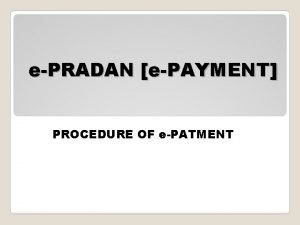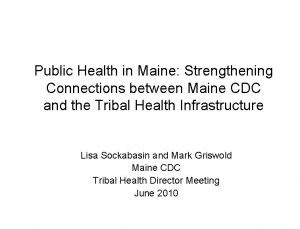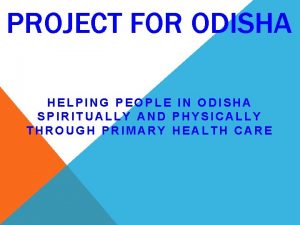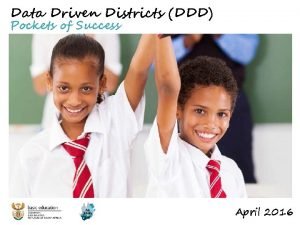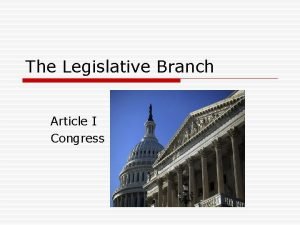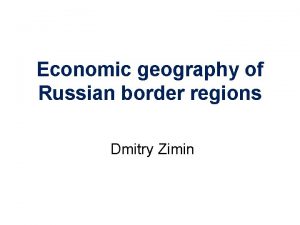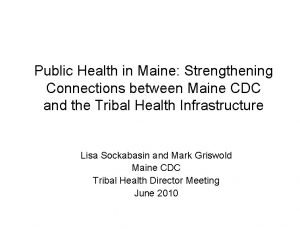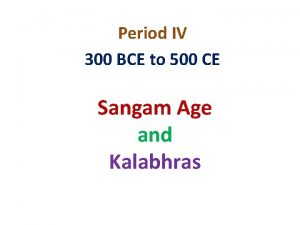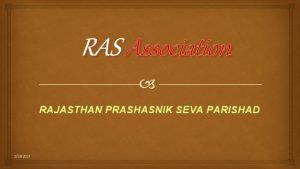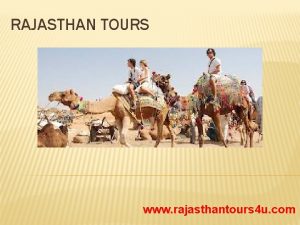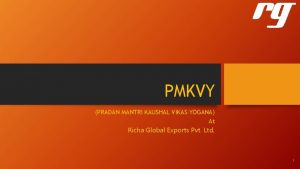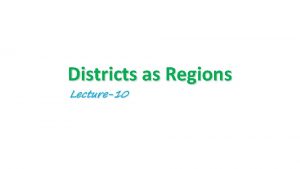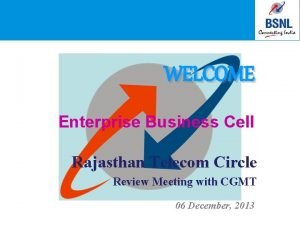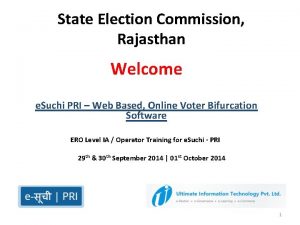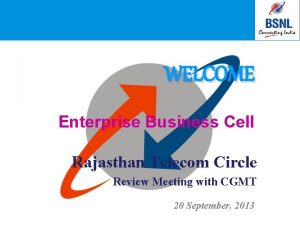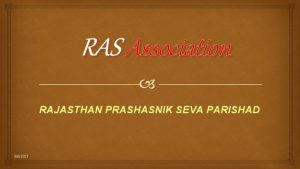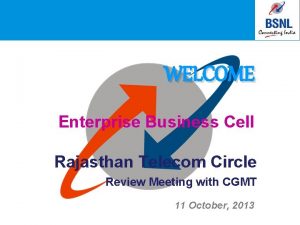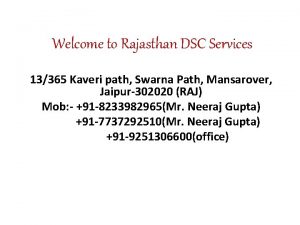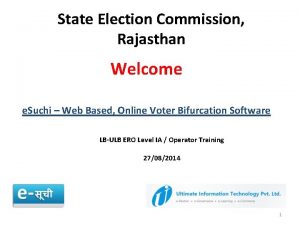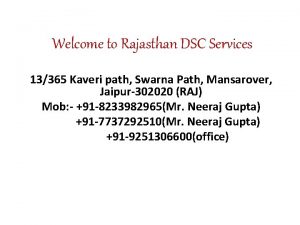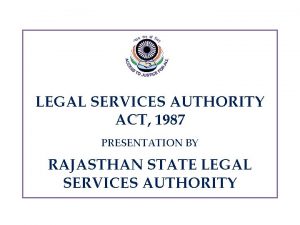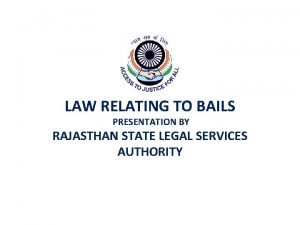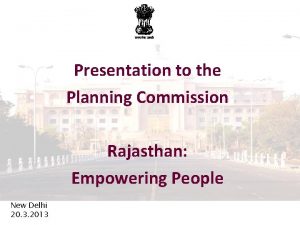Welcome PRADAN presentation PRADAN working Districts in Rajasthan





























- Slides: 29

Welcome PRADAN presentation

PRADAN working Districts in Rajasthan With DPIP Future expansion

Coverage (DPIP) (As on November 30, 06) Particulars Dausa Dholpur Total Entered in agreement July 2003 April 2002 Blocks 1 3 4 Villages 78 126 204 CIGs sanctioned (No) 143 231 374 SP submitted of CIGs (No) 105 188 293 SP sanctioned of CIGs (No) 90 188 278 CIGs received funds (No) 76 180 256 Fund released (Rs Lakh) from DPIP 181 579 760 CIGs linked with banks (No) 14 103 117 Bank loan to CIGs (Rs Lakhs) 7. 43 102 109. 42

Current interventions • Promoting SHGs /CIGs • SHGs – saving and lending among the members, Organising, grooming in SHGs (380 SHGs), clusters (40 cluster) and federations (2) • Leverage bank credit and government funds • Dairy and goat rearing – Induction of quality animal/livestock – Improved rearing practices – Veterinary support and milk marketing, – Creating various system, system setting for sustainability – Promotion of Producers Intuitions and Producers Company • Land & water activities and improved agriculture – Revival & constructions of Paals (RWHS) Land leveling & Bunding , Irrigation – rain water harvesting, Improved cropping practices

Saheli Sangthan (Social Capital to rural poor women)

Current Status (Major activities) Particulars Dairy Goat rearing Dausa Dholpur CIGs formed (No) 63 145 56 75 CIGs sanctioned (No) 61 123 44 69 SP sanctioned of CIGs (No) 49 107 32 63 CIGs received funds (No) 41 107 26 63 Amount of fund released (Rs Lakh) 96 392 70 167 CIGs inducted animals (No) 34 107 17 56 Animals inducted (No) 503 2607 1991 6686

Outreach Detail CIGs Sanctioned Dholpur (231) Dausa(143) Majority Gps of Kushwa: 34% Gurjar: Major caste – 16% Meena: 14% 65%, Mixed. Jatav: 16% Mixed: 20% 35% SC-Bairva, Jaatav, Koli ST 42%SC, 9%ST, 41% Meena, OBC-Kushwah, Gurjars, OBC, 8%Others Mali, Mallah, Others 37%SC, 23%ST, 27% OBC, 12%Others CIGs benefited Land based 180 6 3% 76 0 Dairy Goat rearing Micro Enterprise 107 63 4 59 % 35 % 2% 41 26 9 54 % 34% 12%

Business Processes in DPIP

Subproject process timeline (Months) Dholpur Preparing Gps for livelihoods Time taken for preparation SP Time for sanction of project Time taken for group contribution Time taken for transfer of funds to CIG accounts Time taken for acquisition of assets Dausa Ave Range 18 12 -24 15 12 -24 6 2 -10 3 1 -5 0. 5 1 -2 2 2 -7 2. 5 1 -5 2 1 -3 2 1 -5 3 2 -7 7 3 -18 6 3 -18

CIG performance Dholpur Dausa >Rs. 15000/ month 20% 25 % Rs. 10000 -15000/ month 30% 40 % Rs. 5000 -10000/ month 32% 15 % Up to Rs. 5000/ month 16% 3% No income 2% 17 % Gps acquired additional assets 10% 15% Gps linked to market 55% 50 %

Assets and Insurance % of gp members who lost assets Dholpur Dausa Through sale 3% 3% Death 1% 2% Other Reasons No of gps insured their assets No of claims filed 1% 163 219 1% 51 249 No of claims disbursed 175 189 Pending 12 60

Credit Linkage & Capacity building of CIGs Dholpur Dausa No of CIGs linked with banks (No & %age) Amount of Loan (Rs Lac) Amount of loan/group (Rs Lac) Orientation training of CIG(2 days ) Post Induction Training (2 days) Skill based training of CIG ( 3 days) 103 (57%) 102 0. 99 75 %, 346 days 15 % 94 %, 477 days 14(13%) 7. 43 0. 53 87%, (222 days) 40% 61%,

10 Success Groups Dholpur Dausa Krishi Vikas Samooh Sannupura (IA) Saraswati SRS Malarna (Goat) Sri Ram Domai(Tent) Bhawani SRS Barkhera(Nagina) Bhairon Baba PVS Gironiya(Goat) Banjara SRS Dantli (Trading) Chamad devi MVS Ranpura(Goat) Shankar SRS Khurikhurd(Goat) Baba Maha. Kaleshwar MPVS Kota (Goat) Saraswati SRS Rohra Kalan(Dairy) Laxmi MVS Bhilgavan (Dairy) Laxmi SRS Kableshwar (Goat) Kaila Mata MVS Hansai (Dairy) Puja SRS Bishanpura(Dairy) Karauli Mata MVS Pura Ulavati (Dairy) Samata SRS Kundal (Dairy) Vaishno devi MVS Hanspura(Dairy) Sakhi SRS Khorakhurd(Goat) Santoshi Mata MVS Chandanpura(Dairy) Punjlot SRS Badoli (Dairy)

What has worked • Women SHGs, then livelihood activity • Poor friendly approach (Managed by PRADAN) • Social Capital developed for Poor – poor community(Especially women) organised in groups, clusters and federation • Enhanced confidence, bargaining power, self respect, respect in family of poor women • Skills and Income enhanced • Large number of poor people gets huge funds without cuts, directly to them • Community groups managed funds well

What has worked cont. . • Women acquired assets from govt grant by their complete involvement – Funds withdrawal, counting, payments, exploration, identification, transportation etc first time in life • Involving voluntary sector/NGOs in grass root implementation on large scale • Increased Transparency • Sectoral livelihood promotion (Though came later)

What has worked cont. . Value addition for Livelihoods sustainability (From other sources) • Vet services –ensuring vaccination, deworming, regular health checkups, treatment, emergency cases, castrations, dehorning etc • Poor friendly pamphlets for awareness and medication • Artificial Insemination • Developing local cadre as pashudhan sahyogis • Milk marketing thro federation, bulk cooling, self managed procurement

What has not worked • Time frame of project, Planning (Financial & physical) • Set models/units -not suited for ultra poor • CIG has not, SHG – Saving and credit group worked and has been sustainable. CIG is not sustainable • Up front cash contribution • Single window support through CIG only • One time support-needs more time support (Financial and handholding) • Training extended by Non practitioners

What has not worked cont. . v Limitation of promoting more than one CIG in one village on sectoral cluster approach v Various self imposed constraints vlike purchasing of goats in two phases, purchasing places, involving line deptt, Technical sanctions for exactly same projects, whose rates largely decided by SPMU and number of supporting documents etc. v True partnership in action v. Huge paper work ……… must be avoided v. Non clarity at various level, Procedural delays v Low support to NGOs for linkage with banks, institutional buyers… v Technical bureaucratic bottlenecks, Support by Line deptt

What has not worked cont. . v Human resource –stability, attitude and accountability to poor not as expected v Short period for execution, capacity and vision bldg v Activities are seasonal like land based, dairy etc v Low focus on process part (community dev. ) v Low focus on livelihood (largely asset creation) v No provision for post asset creation support like vet services, post induction, entrepreneurship & business development trainings

What has not worked cont. . 1. Less scope for accommodating ongoing innovations and experimentation 2. Generating group kosh for Livestock CIGs 3. Sanctioning of each step 1. CIGs sanctioning, membership inclusion – exclusion, changes in office bearers, subprojects – technical, administrative and financial, purchase plan sanction 4. Adding new tasks like Sharab bandi, Sarb bhomik Bima, Prashashan aapke dwar, Krishi Aapke dwar etc-has financial implications in task based agreement

What has not worked cont. . • DPMU: limited influence largely in sanctioning and disbursement. • No development support was available to the agencies from DPMU • Similarly SPMU’s influence also limited to administrative (fund flow, administrative and issuing circulars) • Weak support and understanding to the activity cluster (common infrastructure) development • No policy on common infrastructure, inadequate support

What has not worked cont. . v Same guidelines based on CF model for PFTs also, Frequent changes in guideline v Complicated agreements and various changes in project later on • Task basis payment to NGO did not worked. Many NGOs had to withdraw, other raised own fund to carry out DPIP’s work • Rs 70. 31 Lac in Dausa and Rs 105 Lac in Dholpur invested in overhead support for project execution • Where as Rs 7. 89 Lac in Dausa and Rs 10. 51 Lac in Dholpur only can be claimed, financial burden,

What should be next • PFT based execution – Both GO-NGOs in separate operational areas • Larger time frame (5 -7 yrs) in a village – for organizing, grooming, capacity building, livelihood support and handholding • Focus on INRM and livelihood • Balance between sectoral, hybrid and honeybee livelihoods- family focus instead of CIG • Supporting livelihoods of poor needs multi approach, multi doses of support and holding for long term sustainability

What should be Next cont. . • SHG focus, members can take up any livelihood activity • Clear cut institutional building model-SHGs. Cluster-Federation • Linking SHGs for credit with Bank/MFIs • Involve Community in mobilization • Ceiling on subsidy, part subsidy-part loan model, back end subsidy. . • More decision making powers to district level and NGOs ( even for technical assessment)

What should be Next cont. . • Infra development at secondary and tertiary platform of livelihood chain • Cluster based sanctioning, fund release, execution like in Watershed • Lump sum amount for capacity building (Training, exposure) of community and team on disposal of NGO/agency like in watershed • Innovative and flexible funds to address and accommodate value addition and new initiatives at disposal of agency (Lump sum amount can be allotted)

What should be Next cont. . • Livelihood training and capacity building of the implementing and intervening institutions and agencies • Developing cluster with Sectoral intervention, developing common infrastructures for the producers • Developing Producers institutions and Producers Company

What should be Next cont. . • Convergence with other govt program i. e NREGA, Watershed etc to complement and strengthen DPIP support • Involve agencies like Resources and Research Institutions, Financial Institutions including Micro Finance Institutions (MFI), Government Departments and the Markets across. • Applying the principals of Velugu in Rajasthan context

What should be Next cont. . • Bring real term partnership in action – Clear cuts roles & responsibility – Minimize procedures and papers work – So that Thankless collaboration with govt can be replaced with worthful collaboration • Salary based payment /Increased task payment up to Rs 35000/SHGs – Both inputs and outputs cannot become criteria for NGO contract;

• Thanks • for providing this opportunity to share our expereince
 Icegate epayment
Icegate epayment Hard work vs smart work
Hard work vs smart work Cold working vs hot working
Cold working vs hot working Hot working and cold working difference
Hot working and cold working difference Machining operations
Machining operations Proses pembentukan logam
Proses pembentukan logam Texas public school finance overview
Texas public school finance overview Texas recapture districts
Texas recapture districts Sharecropping and tenant farming venn diagram
Sharecropping and tenant farming venn diagram Maine public health districts
Maine public health districts Texas recapture districts
Texas recapture districts Colorado springs school districts
Colorado springs school districts East odisha districts
East odisha districts Define delimit demarcate administrate
Define delimit demarcate administrate Zoning districts
Zoning districts Maharashtra district in 1960
Maharashtra district in 1960 Ddd education
Ddd education Voting districts definition ap human geography
Voting districts definition ap human geography Arizona congressional districts
Arizona congressional districts Iowa state patrol districts
Iowa state patrol districts Russia federal districts
Russia federal districts Map of district 12 hunger games
Map of district 12 hunger games Maine public health districts
Maine public health districts Paris is divided into 20 arrondissements
Paris is divided into 20 arrondissements Chera kingdom map
Chera kingdom map Philippine association of water districts
Philippine association of water districts Connecticut judicial districts
Connecticut judicial districts Category 5 and 6 local authority districts
Category 5 and 6 local authority districts Dpip rajasthan
Dpip rajasthan Ras association rajasthan
Ras association rajasthan
